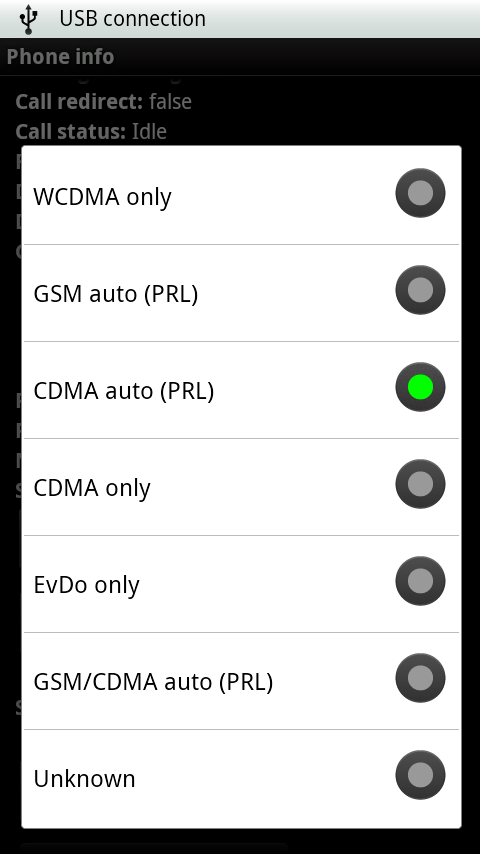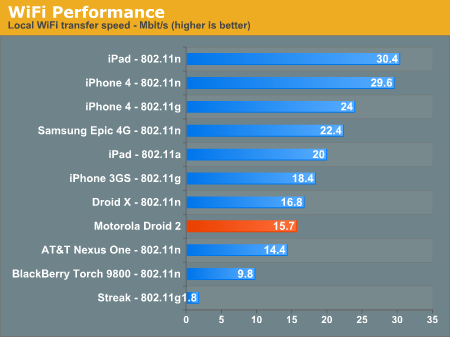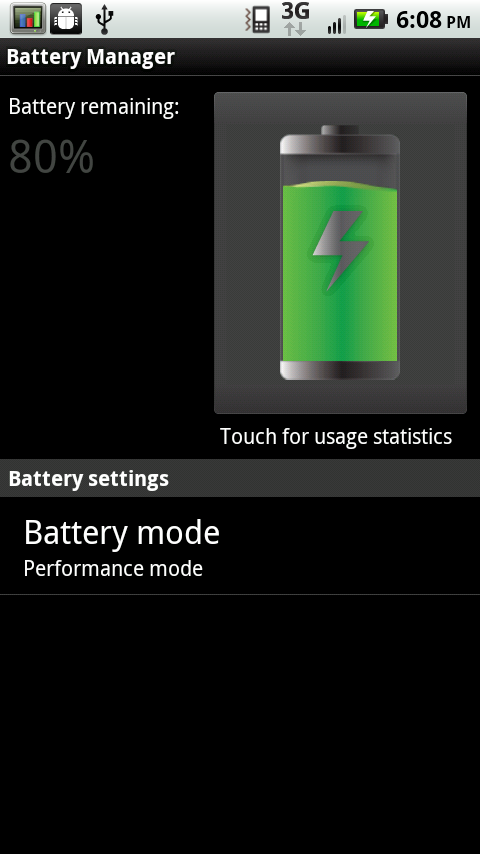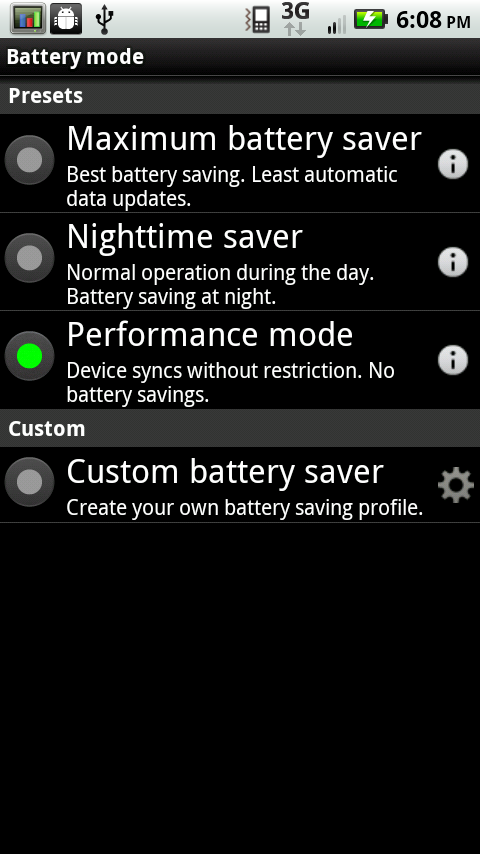Motorola Droid 2 Review: Rebooting the Droid
by Brian Klug on September 19, 2010 7:00 AM EST- Posted in
- Smartphones
- Droid
- Motorola Droid 2
- Android
- Mobile
Cellular and WiFi—Continued
But there’s something else too I believe led to confusion. Motorola has built on the power saving menus and extras they bundled with the Droid X, and the shipping configuration is much more conservative. There’s an extra entry in the settings menu named Battery Manager:
Go inside, and you’ll get a big battery indicator, percentage, a shortcut to see the battery use display Android provides, and something else. Down below is ‘Battery mode’. By default, there are three configurations, and Nighttime saver is selected. Let’s see what it does:
Motorola is basically opting to let you set a schedule for when it should use battery to keep data connections alive. Generally they’re always active, and ready to be used. However, chances are good—if you have a normal sleep cycle—that you won’t use data between sundown and sunrise. Honestly, 10 PM is a bit early for me, as is 5 AM. I won’t even say what hours I’d probably put in here, but basically nothing data is going to happen between these hours by default. Even during setup, there’s a prompt that basically states this has been selected.
You can define your own under custom as well. However if you want the Droid 2 to behave like any other smartphone, select ‘performance mode.’ These titles are somewhat misleading, as none of the three settings appear to actually change system performance—I can still make the Droid 2 run at 1 GHz with load. That behavior remains unchanged. What does is whether the Droid 2 will initiate a data session or sync your accounts.
There’s some benefit to turning data off at night, but only if you don’t regularly plug your phone in before bed. If you’re a smartphone user, you’re probably already in that routine.
I think the introduction of this feature created the primary source of confusion, specifically allegations that data isn’t working as it should be on the Droid 2. I ran just over 100 speedtests on the Droid 2 and averaged 0.715 megabits/s down, and 0.620 megabits/s up on Verizon’s 3G network. The maximum I saw was 2.373 megabits/s down and 1.318 megabits/s up standing about 100 meters with line of sight to a VZW cell tower.
A Lukewarm Hotspot
I didn’t ever have problems with data accessed on the Droid 2 itself. Where I did have massive problems was with tethering on the Droid 2’s built in 3G Mobile Hotspot. Like the Droid X, the Droid 2 has pretty much the same icon and application. In fact, as appearances go, the thing is exactly the same. The difference is that on the Droid X, it worked.
On the Droid 2, my experience was all over the place. I’ve struggled with the Droid 2 hotspot constantly. The problem is that it will just stop working entirely. The hotspot service will pop up with “3G data connection lost”—and the entire hotspot will turn off. It's maddening, every time I was on the go and trying to use the hotspot, I either lacked a USB cable or wasn't quick enough to capture the "3G connection lost" error. It happens so randomly that predicting when the connection is going to drop is nearly impossible.
What’s strange is how sporadic the behavior is. Sometimes the connection will last a solid hour, and be just fine, other times it’ll barely work for 5 minutes. I tested in excellent signal areas, poor signal areas, and with the Droid 2 forced on EV-DO data (no polling of 1x) and forced 1x (slow 2G data) through the *#*#4636#*#* engineering menu—it still drops randomly. I tried all of my laptops and mobile devices, and even swapped through no fewer than three miniPCI-E wireless NICs—it still drops.

This feature is basically broken on the Droid 2. There’s just no other way to state it. If you’re getting the Droid 2 for the built in 3G hotspot feature, reconsider until Verizon and Motorola address it with an OTA update. Or use one of a number solutions from the market, or root. Either way, this was disappointing for me.
Typical WiFi Performance
WiFi performance on the Droid 2 is unsurprisingly on par with the Droid X, as it should be. I saw the Droid 2 negotiate a 65 megabit/s link with a 2x2 802.11b/g/a/n router of mine, which is common for smartphones as we’re starting to see.


GPS is also something a lot of people mentioned regarding the first Droid. When I played with one, I never had fixes take very long, but others did have problems. The Droid 2 thankfully had no issues while testing.
Cold fixes were always speedy as expected. I don’t think anyone will complain about the Droid 2’s GPS performance in all honesty. As always, having WiFi turned on will help get an initial location and speed up the fix, and do a much better job locating you indoors.
















39 Comments
View All Comments
bjacobson - Sunday, September 19, 2010 - link
My Droid's keyboard now has very bubbled keys. Try running your fingernails down and across in the creases beteween keys. I did this a few times pressing hard, went back to typing texts, and it's made my keys bubbled like the Droid2's, even moreso in my opinion than the photograph there.Also, I believe the resistance in the sliding mechanism is the mechanical sliders; I'm pretty sure 2 teflon strips on the back of the phone won't fix that.
sotoa - Monday, September 20, 2010 - link
I like having a dpad on my droid, I just wish it was on the left side like a gamepad, and wish it had diagonals.KaRRiLLioN - Monday, September 20, 2010 - link
I bought the Droid 2 the day it came out but had to return it for several reasons, most of which I hope have been fixed. Corporate email synch had a terrible bug where it wouldn't synch contacts from Exchange if they had categories. Facebook synch would synch EVERYONE instead of just existing contacts. There was no option to change that.Most of these issues were caused by BLUR. Any idea if these items now work as advertised?
So I still have my original Droid with the original flat keyboard. I'm pretty used to it now and have no issues. I think I'll stick to this until another Android-based phone catches my eye. I wouldn't mind something like the Droid X, but I want Super AMOLED.
LoneWolf15 - Monday, September 20, 2010 - link
To fix the Facebook issue, download the Facebook app instead of using the Droid 2's "Social Networking" app.I'm not using my D2 for Exchange (we have a Google Apps Domain) but after a week, I've been very happy with my switch from a Blackberry Tour (which I was reasonably satisfied with).
PubicTheHare - Monday, September 20, 2010 - link
The best keyboard on any smart phone is found on the Epic 4G. I played with it yesterday and was amazed at the tactile feedback and overall usability.Also, I don't buy that the Droid 2 screen is brighter than the Epic/Fascinate/Captivate/Vibrant's.
I have the Fascinate and placed it side by side with the Droid 2, both in a store and against a friend's Droid 2 outdoors, and the Fascinate's display was substantially brighter and had more contrast.
Great review. It seems like Motorola is hitting it out of the ballpark with its latest phones, though I still think they have the most bland styling and their UI (Motoblur) is hideous.
I bet the OMAP processors are about 80% responsible for the impressive battery life. 9.5 hrs is ridiculous!
Thanks, Anand.
Myrandex - Monday, September 20, 2010 - link
The Keyboard does look much better than the original Droid, however it still doesn't look like it comes close to the HTC Touch Pro 2 series phone's keyboard. That one is the thing to beat in my opinion. I love the spaced out offset keys and the dedicated row of numbers at the top. I sure hope my next phone has one at least that good.Jason
silverblue - Monday, September 20, 2010 - link
...that you barely mentioned the Epic 4G and its Galaxy S variants. Not trying to justify my purchase, however the lack of a mention on even the gaming and video capture fronts was a little disappointing.MrPIppy - Monday, September 20, 2010 - link
It's interesting that the Motorola Droids have always been a huge design win for TI, even though almost no other Android phones use TI's OMAP or wireless chips. The Droid, Droid X, and Droid 2 use TI OMAP and WiLink (for WiFi/BT), instead of the almost universal combination of Qualcomm MSM+Broadcom BCM4329. Even Motorola's other Android phones (Backflip, Cliq, etc.) use MSM+BCM4329. Any idea why the Droids get the TI parts?bil3 - Tuesday, September 21, 2010 - link
Surprised that Anandtech doesn't know, but the Droid JIT performance in linpack is normal.Only Snapdragon's scorpion and cortex A9 devices have a fast 128bit FPU which the JIT is optimized for and takes full advantage of.
This is a very specific case for this operating system as it's very much Java based, JIT performance matters in many operations.
The OMAP uses the standard A8 FPU which is anemic in comparison (just like the hummingbird & co.)
The CPU itself is not bad, that's why it's fast enough in raw performance benchmarks or benchs that aren't limited by the JIT.
In all cases, the JIT still bring a good bit of performance, just not as much as on devices with a fast FPU.
Brian Klug - Tuesday, September 21, 2010 - link
Bil3,Very interesting, I wondered for a while about the performance delta being due to the A8 architecture versus Qualcomm's own Scorpion design, but couldn't find that remaining detail. Intriguing that the 128bit FPU makes such a big difference.
Awesome tidbit!
-Brian